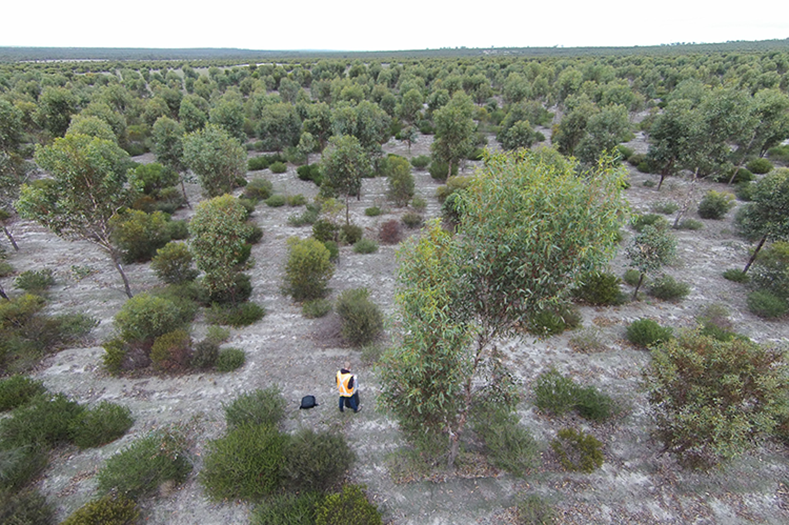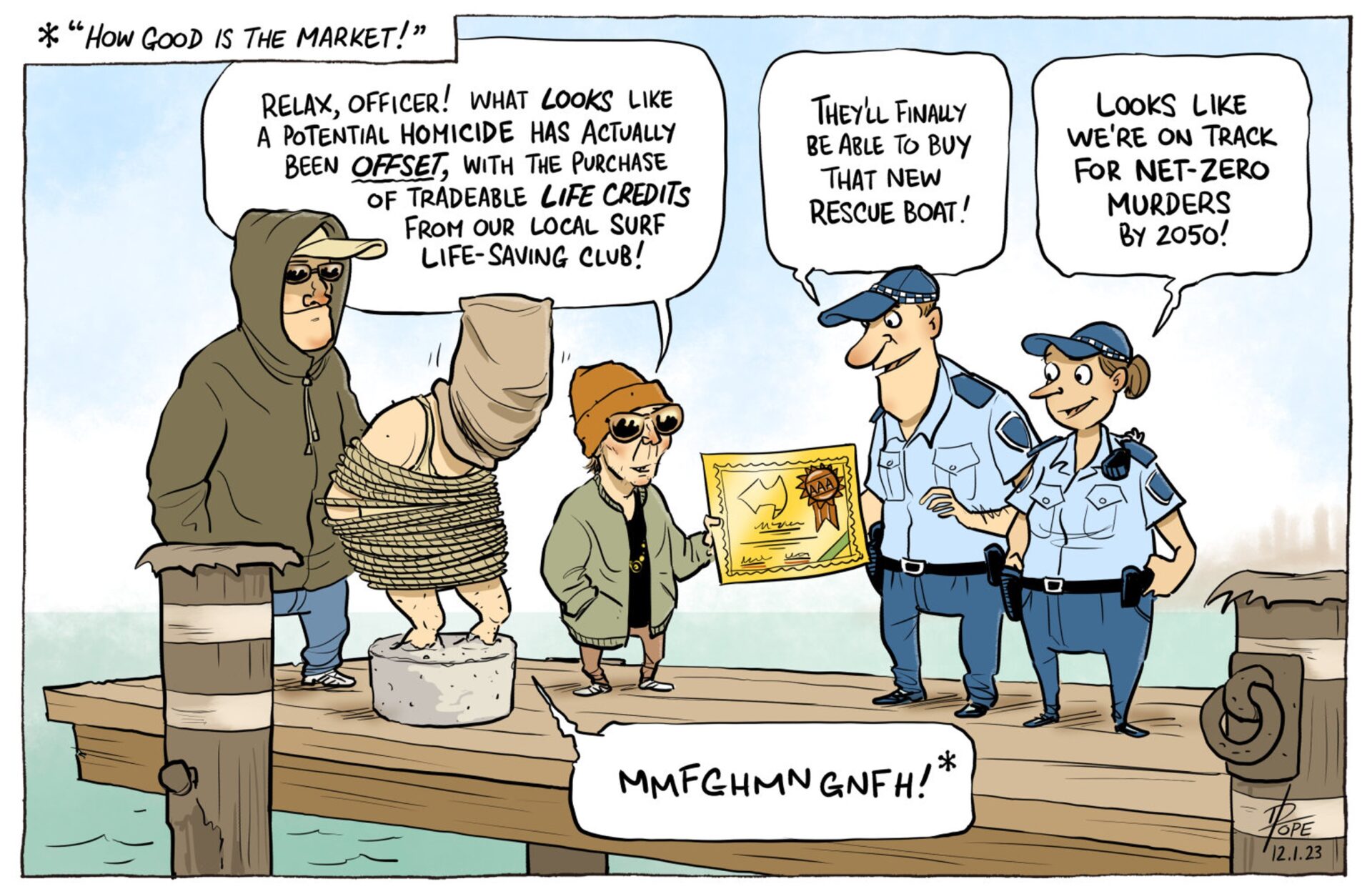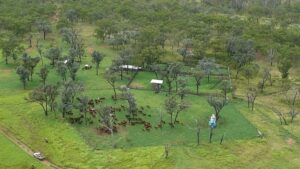The Problem with Carbon Credits and Offsets Explained
Carbon credits are a core pillar of Australia’s climate change strategy. However, depending on offsets to meet emission reduction goals is mathematically impossible and a recipe for climate disaster.
What’s a carbon credit?
Carbon credits are made by carrying out activities that store, reduce or avoid greenhouse gas emissions.
These include retaining vegetation instead of clearing it, capturing gas from landfill and removing cattle from land.
In Australia we have a government-run carbon credit scheme that gives Australian Carbon Credit Units (ACCUs) to projects for carrying out these activities.
Projects earn one carbon credit for every tonne of carbon dioxide or carbon dioxide equivalent (CO2e) stored or avoided by a project.

There are rules called ‘integrity criteria’ that have to be followed that ensure the carbon credits legitimately avoid or reduce CO2e. Integrity criteria, among other things, ensure the reduction is real, permanent and that it wasn’t going to happen anyway.
Once a project can demonstrate it has met these criteria and stored or avoided carbon, the government gives the project a carbon credit. When projects are issued with carbon credits, they can either sell them back to the government or businesses needing to ‘offset’ their emissions.
What’s an offset?
When a business buys a carbon credit it is usually to justify or compensate for putting emissions into the atmosphere. The idea is that someone else has reduced or avoided a tonne of CO2 so a business can buy the credit that represents that reduction and use it to ‘offset’ their own emissions. It’s essentially an accounting trick.
Carbon credits may result in emissions reductions at a project level. But even if you assume all carbon credits are perfect (spoiler; they’re not), when they’re used as offsets they, at best, only maintain the status quo. They simply mean emissions are being theoretically moved from one sector to another. Ie from the fossil fuel industry to the land sector (which is where most carbon credits come from).
When carbon credits are low integrity, no reduction in emissions is occurring at all at a project level. When they are used to offset emissions, the result is an increase in emissions.
That’s the theory…what about practically?
What are they offsetting?
While the maths of offsetting is simple, in real life it’s not so neat.
Firstly, when companies (or countries) say they’re ‘net-zero’ or ‘carbon neutral’ you’d think they mean they’ve offset all their emissions to get there. But that’s not what happens. The fine print on these claims is that they are net-zero for their ‘operations’, which is some of their emissions. Usually they mean their business operations, like offices, warehouses and car fleets, and don’t count the emissions from the products they make which is where most emissions come from.
It’s a bit like saying you’re a health food company even though you sell chicken nuggets, because everyone in your office eats salad for lunch. It’s a bit misleading.
Integrity issues with carbon credits
The second big issue is that we’re frequently seeing carbon credits are not worth the paper they’re written on, and are not representing real emissions reduction.
A recent Four Corners investigation revealed extensive commercial logging occurring in a rainforest carbon project located in Papua New Guinea. Trees that the project developer had promised to protect — to sequester CO2 — were being removed for logging within the project area. Meanwhile, Australian businesses were buying these fraudulent credits, believing they were ‘offsetting’ their emissions.
This is just one of many examples.
Last month a report revealed that more than 90% of rainforest offsets from Verra, the world’s leading carbon project verifier were worthless and did not represent genuine carbon reductions. In large part, this is because credits have been awarded for protecting remnant forest areas that were unlikely to be cleared.
In Australia, research from ANU and UNSW, the Australia Institute and a number of independent researchers and academics has highlighted integrity issues with Australia’s own national carbon credits, called ACCUs. There is significant evidence that up to 75% of ACCUs are not resulting in real emissions reductions or are not ‘additional’.
Our research found that ‘avoided deforestation’ projects, which make up 1 in 5 of all carbon credits in Australia, do not represent genuine abatement. In most cases, credits were issued for protecting areas were never going to be cleared. That’s like reducing tobacco use by paying non-smokers not to smoke.
Whistle-blower Professor Andrew Macintosh, who was the former head of the government’s Emissions Reduction Assurance Committee, described the carbon credit system as a fraud that is hurting the environment and consumers. At our Climate Integrity Summit he spoke about ‘human-induced regeneration’ projects. These are land-based projects which are awarded ACCUs for allowing cleared native forest to regenerate. His research with the ANU examined 119 projects (issued a total of 17.5 million ACCUs) where total forest area had not increased. Credits were being handed out for land that was never cleared to begin with. Egregiously, for 59 of the projects, the amount of forest was found to have reduced. These projects still received 8.2 million carbon credits, worth more than $100 million.
Additional problems relate to other common carbon projects including those that award ACCUs for reducing methane emissions at landfill sites.
Whatever the project type, the problem is the same. When junk credits are used as offsets, the result is an increase in total emissions.
Offset and forget?
As Dr Bill Hare highlighted at our Climate Integrity Summit, the impermanence of carbon offset projects pales in comparison to the thousands of years that fossil fuel emissions stay in the atmosphere. In Australia, carbon offset projects need to guarantee permanence of emissions reductions for just 25 or at most 100 years.
And as climate change produces a hotter and drier Australia, the likelihood of long-term carbon storage in soil and in vegetation decreases. The preservation of the world’s natural carbon sinks is an incredibly important exercise – bringing biodiversity and other benefits. However, there is extensive literature documenting the measurement uncertainties and significant risks of relying on natural ecosystems to store fossil carbon emissions.
Safeguarding what exactly?
All of this becomes even more alarming when you consider that the Safeguard Mechanism — Australia’s key policy for reducing greenhouse gas emissions from our biggest polluters — relies heavily on offsets. In fact, at face value it actively incentivises offsetting.
As we detail in our Safeguard explainer, there’s a dangerous loophole in the Mechanism that allows polluters to simply purchase carbon credits to offset emissions, rather than making the fundamental and required changes to decarbonise their operations. Allowing companies to offset also opens the door for fossil fuel producers to continue expanding their operations (and their emissions).
The Safeguard Mechanism is dominated by the coal, oil and gas industries that have no means or plans to reduce their emissions. Thus, it will drive unprecedented demand for carbon credits, not decarbonisation.
With no plans to stop approving new gas and coal, the government is under pressure to provide an ongoing supply of affordable carbon credits to industry.
Allowing unlimited access to offsets will mean Australia’s emissions are at risk of increasing under the Safeguard Mechanism. If the offsets are junk, the situation will be even worse. Again, if these credits are junk, Australia’s emissions will increase.

Delay or decarbonise?
Australian climate policy over the last few years has led to increases in private investment in carbon credit projects and a large supply of carbon credits on the market available to big emitters. This has in turn kept the price of carbon credit suppressed. If it’s cheaper and easier to buy carbon credits, companies will invariably take this route rather than actual decarbonisation.
When you look at the data, as we’ve done, you see that investment in renewable energy generation has halved since 2018, while the number of carbon offset projects tripled over the same timeframe.
Australia used to have a climate policy that encouraged decarbonisation. Back in 2000, the Australian Government introduced the Renewable Energy Target, which achieved 45 million tonnes of emissions reduction by increasing the percentage of renewables in Australia’s energy system.
The Renewable Energy Target (RET) was so successful in Australia because the Government mandated the purchase of renewable energy. The Government may have said it will get to 82% renewables in the grid by 2030 but there’s no policy that would drive investment the way the RET did. The Target was reached early in 2019. However, since that target was met, a new one hasn’t been introduced, essentially phasing out that policy. We’ve seen a slump in renewable energy investment since.
It’s simple. If we have policies like the RET that drive permanent decarbonisation, then that’s what will follow.
Conversely, if we allow polluters to freely offset using junk carbon credits, we delay actual decarbonisation while simultaneously threatening to increase Australia’s actual emissions.
What’s next?
As climate researcher Ketan Joshi put it “carbon offsetting is an honesty system coupled with a financial incentive for dishonesty.”
Every dollar spent on offsets is a dollar that doesn’t go towards something that actually reduces emissions and displaces fossil fuel use.
A climate policy that allows fossil fuel expansion and obstructs decarbonisation is not a climate policy. A credible climate policy would see Australia put an end to new gas and coal projects and ensure that industry makes genuine reductions in emissions.
As the Albanese Government looks to legislate the Safeguard Mechanism, they would do well to close the offset loophole, or risk (off)setting us up for further climate chaos.
Between the Lines Newsletter
The biggest stories and the best analysis from the team at the Australia Institute, delivered to your inbox every fortnight.
You might also like
Here are 23 Times Carbon Offsets Were Found to be Dodgy
Carbon offsetting has received a lot of attention recently. As businesses and governments look to meet their climate targets, many are turning to carbon offsets. That is, they are paying someone else to reduce or avoid putting greenhouse gases into the atmosphere, so they don’t have to.
The carbon con killing koalas
The NSW Labor Government took office promising to create a vast koala sanctuary on the state’s mid-north coast – the Great Koala National Park. Despite the threat of koala extinction in the state, more than a year later the Great Koala National Park is yet to be established.
Can carbon offsets save the environment?
If you’ve ever ticked ‘yes’ to offsetting your carbon emissions when you booked a flight, it might have felt like you were doing something good. Planting some more trees to make up for your trip certainly offsets our guilt. But does it actually take carbon out of the atmosphere?




